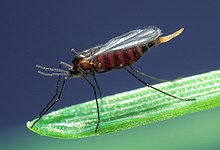| Hessian fly | |
|---|---|

| |
| Scientific classification | |
| Domain: | Eukaryota |
| Kingdom: | Animalia |
| Phylum: | Arthropoda |
| Class: | Insecta |
| Order: | Diptera |
| Family: | Cecidomyiidae |
| Genus: | Mayetiola |
| Species: | M. destructor
|
| Binomial name | |
| Mayetiola destructor (Say, 1817)
| |
| Synonyms | |
|
Cecidomyia destructor Say, 1817 | |
The Hessian fly or barley midge, Mayetiola destructor, is a species of fly that is a significant pest of cereal crops including wheat, barley and rye. Though a native of Asia, upon its discovery it was believed to have been transported into North America in the straw bedding of Hessian troops during the American Revolution (1775–1783), thus the origin of its common name. However, the report of an inquiry made in 1788 by Sir Joseph Banks states that "no such insect could be found to exist in Germany or any other part of Europe". Nonetheless, it appears that this species, or one exactly like it in habits, had been known for at least a century prior to the American Revolution from a locality near Geneva, and also for a long time from some regions in France.[1]
There are usually two generations a year but may be up to five. In the spring the dark-coloured female lays about 250 to 300 reddish eggs on plants, usually where the stems are covered by leaves; the larvae feed on the sap and weaken the plants so that they cannot bear grain.
The Hessian fly was described by Thomas Say in 1817. It is a very harmful insect. It mainly attacks the stem, although if it is especially hungry it will eat any part of the plant it can find.[citation needed]
In 1836, a severe infestation of Hessian flies resulted in a crop shortage aggravating the financial problems of farmers prior to the Panic of 1837.[2]
- ^ Harris, Thaddeus W. (1862). Flint, Charles L. (ed.). A treatise on some of the insects injurious to vegetation. New York: Orange Judd and Company. p. 568. doi:10.5962/bhl.title.34053.
- ^ McGrane, Reginald Charles. (1924, 1965) The Panic of 1837: Some Financial Problems of the Jackson Era. New York: Russell & Russell Inc.